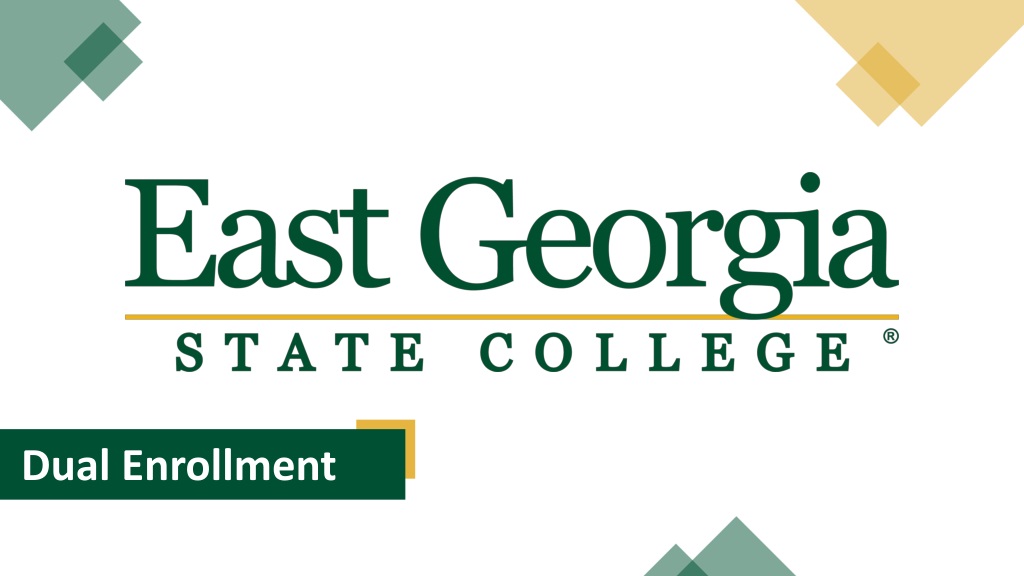

0 likes | 11 Views
Simultaneous enrollment in high school and college courses where college courses count towards high school graduation requirements. Students can earn extra points towards their HOPE GPA and receive funding for up to 30 credit hours. Eligibility criteria, application process, funding limitations, and contact information are provided.

E N D
Program Information ● Simultaneous enrollment in high school and college courses ● College courses will count towards your high school graduation requirements ● Receive extra half point up to a 3.0 for Dual Enrollment courses toward their HOPE GPA ● Can enroll at multiple institutions w/counselor approval ● FREE for up to 30 credit hrs OPTIONAL and recommended, not required
Cautions ● Your professors will not know you are a dual enrollment student, so they will treat you like a college student ● Your college GPA will follow you! ● College and high school calendars do not always align o Fall/Spring/Winter Break o Extracurricular activities o Attendance policies • Reach out to instructors first when there is an issue • Failing or withdrawing can affect your graduation status!
What is covered ● Tuition* ● Mandatory student fees ● Textbook rentals (lab manuals included) ● Physical ● OER – open resource ● Access Codes *State funding willcover up to30credit hours of approved courses
What is not covered ● Parking passes ● Dining plan ● Course fees ● Housing ● Transportation
Who is eligible? ● Juniors and Seniors ● 10th graders require 1200 SAT or 26 ACT ● 3.0 unweighted HOPE GPA ● EGSC evaluates only courses that are considered part of the USG recognized 17 Required High School Credits ● Overall GPA is insufficient (Band, ROTC, PE, etc.) ● Be on track to complete Required High School Curriculum ● Test scores not required but recommended
Application Process ● Meet with your hs counselor to see if you are eligible based on your HOPE gpa, ACT, SAT, etc. ● Apply to the college ● Send transcripts/test scores ● Complete funding application for dual enrollment ● Get registered ● HS counselor or student can schedule with the dual enrollment counselor at the college
Placement Students must meet the following course criteria: ● English: Two units of RHSC English must be successfully completed prior to the start of the Dual Enrollment term; and, ● Eligible for English, History, Sociology, Government, etc. ● Math: High school Algebra II or the equivalent must be successfully completed prior to the start of the Dual Enrollment term. ● Math course placement is based on GPA and standardized test scores. ● 3.2 for College Algebra ● Test scores are no longer required Students who have taken PSAT, SAT, PreACT, ACT, or Accuplacer can submit scores to assist in additional course placement
Funding Limitations ●30 credit hour cap ●2 withdrawals, no repeated courses ●Only approved courses Go to GAFutures to see the full course directory!
Obtain Funding 3 step process: ● You and your parent/guardian must complete the GAFutures Funding Application/Participation Agreement ● You will need to have met with your high school counselor first to go over what classes you will be approved to take as a dual enrollment student ● Your high school counselor must complete their part of the GAFutures Participation Agreement and courses(s) to be taken
AP vs Dual Enrollment ● AP is recognized nationwide. ● Students must take and pass AP exam to receive college credit. ● Students must pay for AP exam (some free test options available). ● Students with the highest ACT and SAT scores tend to take the most AP classes. ● Which is more important, getting ahead or being prepared?
Contact Information Morgan Clifton Dual Enrollment Coordinator morgan_clifton@ega.edu 478-289-2022 Jennifer Fields Director of Admissions jfields@ega.edu 478-289-2129